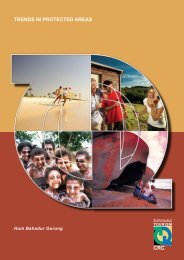icolls - Sustainable Tourism CRC
icolls - Sustainable Tourism CRC
icolls - Sustainable Tourism CRC
Create successful ePaper yourself
Turn your PDF publications into a flip-book with our unique Google optimized e-Paper software.
ECOLOGY, THREATS AND MANAGEMENT OPTIONS FOR SMALL ESTUARIES AND ICOLLS<br />
CONTENTS<br />
ABSTRACT____________________________________________________________________________ VI<br />
ACKNOWLEDGEMENTS _______________________________________________________________ VI<br />
SUMMARY ___________________________________________________________________________ VII<br />
CHAPTER 1 THREATS TO THE ECOLOGICAL HEALTH OF ICOLLS: A REVIEW WITH<br />
EMPHASIS ON SMALL ICOLLS IN AUSTRALIA ___________________________________________ 1<br />
ABSTRACT ____________________________________________________________________________ 1<br />
INTRODUCTION ________________________________________________________________________ 1<br />
PROCESSES THREATENING THE ECOLOGICAL HEALTH OF ICOLLS _________________________________ 4<br />
Threatening Process 1: Eutrophication and Contamination_____________________________________ 4<br />
Threatening Process 2: Fisheries _________________________________________________________ 6<br />
Threatening Process 3: Artificial Berm Breaching and Modification of Flow Regimes _______________ 8<br />
Threatening Process 4: <strong>Tourism</strong> and Recreational Use of ICOLLs______________________________ 11<br />
Threatening Process 5: Coastal Development and Habitat Loss – Implications for Conservation ______ 12<br />
KNOWLEDGE GAPS, RESEARCH PRIORITIES AND ECOLOGICALLY SUSTAINABLE MANAGEMENT PRACTICES<br />
FOR ICOLLS _________________________________________________________________________ 13<br />
CHAPTER 2 MARINE SUBSIDIES SUPPORT ICOLL FOOD WEBS: THE DEVELOPMENT OF A<br />
MARINE PULSE CONCEPT _____________________________________________________________ 14<br />
IMPLICATIONS OF CATCHMENT MODIFICATIONS ON ICOLL FOOD WEB STRUCTURE AND FUNCTION______ 14<br />
CONCEPTUAL APPROACH TO CARBON FLOW IN ICOLL FOOD WEBS ______________________________ 14<br />
MATERIALS AND METHODS ______________________________________________________________ 16<br />
Site Selection_______________________________________________________________________ 16<br />
Sampling Methods___________________________________________________________________ 17<br />
Laboratory Sample Processing _________________________________________________________ 17<br />
Analytical Methods __________________________________________________________________ 18<br />
RESULTS ____________________________________________________________________________ 18<br />
Isotopic Analyses ___________________________________________________________________ 19<br />
DISCUSSION __________________________________________________________________________ 24<br />
Biological Diversity and Conservation Value of ICOLLs_____________________________________ 24<br />
Stable Isotope Signatures of Biota in ICOLLs _____________________________________________ 24<br />
Opening Regimes and Carbon Flow in ICOLLs ____________________________________________ 24<br />
Conclusions and Implications __________________________________________________________ 24<br />
CHAPTER 3 SEWAGE EFFLUENT SIGNIFICANTLY INCREASES THE ∆ 15 N SIGNATURES OF<br />
RESIDENT BIOTA IN AN INTERMITTENTLY OPEN ESTUARY ____________________________ 26<br />
INTRODUCTION _______________________________________________________________________ 26<br />
MATERIALS AND METHODS ______________________________________________________________ 27<br />
Sampling Sites______________________________________________________________________ 27<br />
Sampling Methods___________________________________________________________________ 27<br />
Laboratory Sample Processing _________________________________________________________ 28<br />
Analytical Methods __________________________________________________________________ 28<br />
RESULTS ____________________________________________________________________________ 28<br />
Community Composition _____________________________________________________________ 28<br />
Stable Isotopes______________________________________________________________________ 29<br />
Intraspecific Variation in δ 15 n Signatures in Tallows Creek ___________________________________ 30<br />
DISCUSSION __________________________________________________________________________ 33<br />
Sewage Effluent and δ 15 n Signatures of Biota in Tallows Creek _______________________________ 33<br />
Food Web Structure and Function in Tallows and Belongil Creeks _____________________________ 33<br />
Patterns of Fish Movement Inferred from Nitrogen Isotope Signatures __________________________ 34<br />
iii











